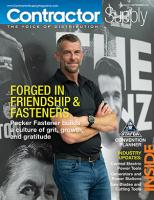Exclusive: What’s Sinking Your Employee’s Wellbeing?
5 "Titanic" lessons for leaders to keep their crew afloat.
By Diane O’Connell
 The sinking of the Titanic stands as a tragic and haunting reminder of human fallibility. And, surprisingly, the parallels between the Titanic disaster and today's workplace wellbeing cultures are striking.
The sinking of the Titanic stands as a tragic and haunting reminder of human fallibility. And, surprisingly, the parallels between the Titanic disaster and today's workplace wellbeing cultures are striking.
The Titanic, once deemed "unsinkable," faced unforeseen challenges, inadequate preparation, and communication breakdowns – all factors that bear an uncanny resemblance to issues plaguing today’s workplaces.
The correlation demonstrates that critical aspects of employee wellbeing, such as mental health, communication, and a feeling of psychological safety, impact the business’ management of risk, profitability and productivity no matter what the situation.
This article embarks on a journey to unravel the synergy between the Titanic's tragic narrative and the intricate tapestry of workplace culture to shed light on valuable lessons that can be applied to foster healthier, more resilient, and safer work environments. So, let’s explore the correlation between history's most infamous shipwreck and the ever-evolving landscape of workplace wellness.
1. Lack of Vision (mental health):
The Titanic had binoculars hidden away in a locked cabinet. Yet, these crucial tools remained untouched throughout the voyage. The reason? A lack of confidence and the fear of consequences, because the ship was brand new, prevented the crew from breaking the glass cabinet to access them. Not feeling empowered to make the decision left them with severely limited vision, so they didn’t see the iceberg until it was too late.
Just as the Titanic's fate could have been different with better vision, business leaders today should heed this lesson and equip their talent with the necessary tools and insights to ensure forward vision and the confidence to take action. It's not enough to thrive in the present; leaders must prepare for the future, recognizing that mental wellbeing directly impacts productivity, which directly impacts profits.
This proactive approach guarantees that wellbeing programs and benefits remain effective and adaptable, capable of meeting the ever-evolving demands of the modern workplace.
2. Communication Breakdown (setting expectations):
Just as poor communication protocols and delayed response played significant roles in the Titanic disaster, within an organization, they can have a ripple effect that deteriorates the workplace culture.
In the absence of clear communication channels, information isn't adequately disseminated and feedback mechanisms fail, so employees' access to vital support and resources become compromised. This, can lead to a decline in overall productivity.
Much like the Titanic crew needed clear communication protocols to navigate expectations and obstacles, modern organizations must foster an environment of open and honest communication, where expectations are well-defined and readily accessible so employees can be fully engaged and effectively address the evolving demands of today's workplace. In doing so, leaders not only enhance employee satisfaction, mental health, and productivity but also safeguard their profits from potential disasters on the horizon.
3. Neglecting warning signs (leadership):
The Titanic received several warnings about icebergs in its path, which were not adequately heeded because they prioritized sending messages for the first-class passengers. Similarly, poor workplace cultures may neglect warning signs of employee distress, such as high attrition, increased absenteeism, or declining productivity because it is focusing attention in the wrong areas. When leadership fails to recognize and address these signals, the repercussions can be profound, impacting employee satisfaction and overall wellbeing which can lead to disengagement.
By actively recognizing and addressing signs of employee distress, they not only enhance well-being but also safeguard the overall health and success of the organization. In this era where leadership and employee wellbeing are intrinsically linked, astute and empathetic leadership can make all the difference.
4. Inadequate planning (crisis/risk management):
The Titanic's sinking was partly attributed to insufficient planning and failure to account for potential risks, such as ICEBERG COLLISIONS! Inadequate workplace wellbeing programs often stem from a lack of strategic planning and risk assessment. Neglecting to anticipate and address employee wellbeing issues can set the stage for increased stress, burnout, disengagement, and physical and mental illnesses which increases the risk of attrition, injuries, employee driven lawsuits, costly mistakes, and eventually customer dissatisfaction.
The Titanic serves as a sobering reminder that crisis and risk management are essential. Organizations can proactively identify and mitigate risks by safeguarding not only the health and happiness of their workforce but also their own stability and success in an ever-changing and challenging business environment. In this era where wellbeing and risk management are intertwined, foresight and preparedness can make all the difference.
5. Insufficient resources and support (profits):
The Titanic was designed with limited lifeboats, a short-sighted and arrogant approach that prioritized profits over passenger safety. Similarly, inadequate resources and support allocated to workplace wellbeing programs can hinder their effectiveness. When organizations cut corners with insufficient funding, lack of dedicated staff, or inadequate training, they risk limiting the program's ability to address the pressing needs of their employees.
In today's workplace landscape, organizations must recognize that investing in comprehensive programs not only benefits their employees but also contributes to their long-term prosperity. Organizations must understand that neglecting employee well-being can lead to negative outcomes, impacting both their people and their bottom line. A holistic and comprehensive commitment to employee welfare is a wise and forward-thinking strategy that ensures lasting success and sustainability.
Conclusion
The parallels drawn between the Titanic disaster and the realm of workplace culture underscore critical lessons for organizations striving for success. The Titanic's tragic fate, serves as a stark reminder of the importance of proactive strategies and resource allocation in safeguarding the wellbeing of the business and its employees so they can navigate the complex waters of today’s business world with confidence and resilience.
By addressing risks, providing ample resources, and staying attuned to warning signs, creating robust wellbeing programs with effective communication and a vision for adaptability are the essential tools in navigating the complex waters of today's ever-evolving workplace.
So, don’t make the titanic error of neglecting workplace wellbeing as a “nice to have” initiative. Instead, chart a course towards a healthier, more prosperous and resilient future by prioritizing the wellbeing of your organization’s greatest asset—its employees. CS
Diane O’Connell is an author, speaker, coach, workplace culture reinvention strategist and attorney and mediator. After being diagnosed with Generalized Anxiety Disorder (GAD), Diane left the practice of law to focus on helping businesses create measurable success, reduce risk and improve profitability with a workplace culture of wellbeing that works at Sorting it Out, Inc.















